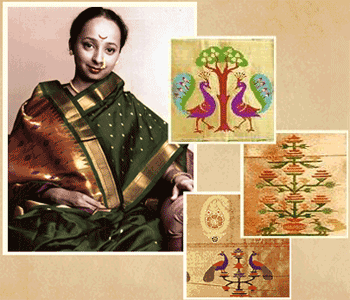 |
|
| 2. The Legend of The Paithani |
|
 |
The Paithani is more than just a silk saree. It speaks of art, of culture.
It is a legacy, an heirloom!
The Paithani saree tell a tale. A tale that is laid deep in history. A tale of silk, of zari. A tale of beauty, elegance and grandeur.
A tale of tradition. |
| 6 |
|
|
Born in Maharashtra, the Paithani saree dates back to times as early as the Rigveda. In the 18th century the Paithani
thrived under the patronage of the Peshwas. It is believed that Madhavrao Peshwa had a special love for Paithani textiles. Legend also
has it that the Paithani caught the fancy of the Nizam of Hyderabad too and that it was his daughter in law Nilofer who introduced new
motifs to the border and pallav designs.
So what is it about the Paithani that is so enticing? Is it the silk, the colours, the designs, the zari? Perhaps its just the sheer richness
of it as a whole. Its fabric is woven entirely on handlooms. It is a confluence of gorgeous colours and intricate designs. A simple tabby weave
brings together two different coloured threads to achieve a dhoop-chhav effect. The otherwise plain Paithani is given its grandeur by its
ornamental zari border and pallav. In the olden times the zari was drawn from gold. Today this has been replaced by the more affordable silver.
Change is the call of the day. The Paithani too has evolved with times. From the traditional plain saree with a heavy zari border today's
Paithani's are embellished with ethnic motifs like tota-maina (parrot), bangdi-mor (peacock with a round design), asavali (flower and vine),
narli (coconut), keri (mango) - all these making the Paithani a perfect blend of the aesthetic and the symbolic. |
| 7 |
|
 |
| |
|
|
| |
| Website Homepage |
| Mangalam sarees, Pune, a home to exclusive silk, cotton sarees, Paithani, Kanjeevaram silk sarees, Banarasi sarees, Gadwal, Pochampalli saree, Maheshwari, Chanderi sarees, Patola. |
|
|
|